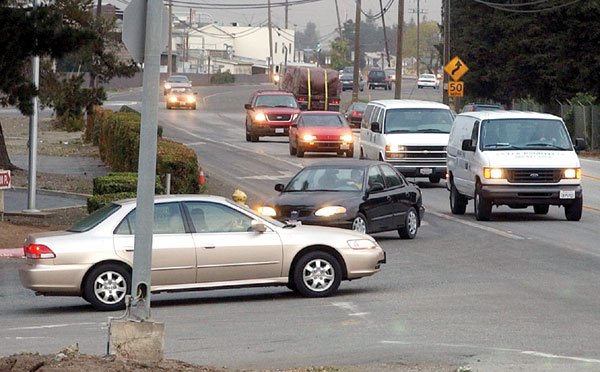GILROY
– Ask any Gilroy Foods worker: heading home from work from the
company located on Highway 152, where the road narrows from four
lanes to two, is a real headache. Now, County Supervisor Don Gage
has made relieving that pain his
”
top priority
”
for any money left over from Measure B, a half-cent sales tax
voters approved in 1996.
GILROY – Ask any Gilroy Foods worker: heading home from work from the company located on Highway 152, where the road narrows from four lanes to two, is a real headache. Now, County Supervisor Don Gage has made relieving that pain his “top priority” for any money left over from Measure B, a half-cent sales tax voters approved in 1996.
He’ll need the backing of at least two other supervisors on the county’s five-member board to prevent the job from being delayed indefinitely, but he’s optimistic.
The plan would cost roughly $12 million: about $250,000 for a stoplight, perhaps $3 million to widen Highway 152 to four lanes from Gilroy Foods east to the Llagas Creek bridge and the remainder to extend the four lanes over the creek.
Pacheco Pass Highway narrows right in front of the city’s third largest employer, Gilroy Foods, with 612 workers strong. Predictably, when it’s time for the day shift to go home, the bottlenecked traffic can get slow.
At the beginning of nearly every weekend, it’s much worse, as employees compete with travelers shuttling between U.S. 101 and Interstate 5. At the busiest times, pulling out of the Gilroy Foods employee parking lot can take 15 minutes, Plant Manager Bob Cates said.
Make it a holiday weekend, and the gridlock becomes “unbearable,” according to Gage. Gilroy Foods officials are looking forward to Nov. 26 – the day before Thanksgiving – the way a 6-year-old anticipates a trip to the dentist.
A stoplight and added traffic lanes are the generally accepted solution, but the problem is nothing new. Cates says the company has been pitching the idea to the city and county since before he started working there 16 years ago.
“We’re not going to go away, but jeez, it doesn’t seem fair,” Cates said.
There’s a proposal on the table to hold off on the expensive bridge work and first build the stoplight and extra lanes west of Llagas Creek. Cates says this would solve his company’s problem, and outgoing Gilroy Mayor Tom Springer supports it. Gage said he’s willing to split the project up if necessary, but he’s “shooting for the whole thing.”
Measure B already has delivered a widened U.S. 101 from Gilroy to south San Jose (under budget), a widened Interstate 880 near San Jose (over budget) and two projects on Highway 152 at U.S. 101: widening 152 to four lanes from the 101 to Gilroy Foods (including a stoplight at the new Camino Arroyo, by two new shopping centers) and improved on-off ramps at the interchange that are scheduled to be finished in January.
Although the 1996-measure tax will be collected until 2006, it’s nearly spent. While the bigger projects are done, there won’t be enough money for everything promised in 1996, Gage says, and the Gilroy Foods stoplight/widening is one of several smaller projects left fighting for the scraps that become available as other projects come in under budget.
Yet the three jobs Gage sees as the “major” candidates for funding are all in his district, meaning other supervisors might defer to him on them. Besides Highway 152, these are on state Highway 17 between San Jose and Santa Cruz and on state highways 85 and 87 in San Jose.
“My priority is Highway 152,” Gage said. “It’s a safety issue and a real traffic issue to the community.”
If Gage can’t get the county to fund the project, it will have to wait on state transportation grants that come out every two years. Because the 2004 grants are spoken for, the Gilroy Foods project would first be eligible in 2006.
Meanwhile, Gilroy Foods has to address its employees’ frustrations somehow. Next Wednesday, as it does at the beginning of every holiday weekend, the ConAgra-owned company has arranged for California Highway Patrol officers to part traffic and let day shift employees out at 2, 2:30, 3 and 3:15 p.m.
“If it wasn’t for that, they wouldn’t be able to get out,” Cates said. “We’ve helped this as much as we can by staggering our shift, but there’s only so much we can do.”
That section of road is so notorious that the post office won’t deliver mail to Gilroy Foods anymore, Cates said. The mammoth plant has a P.O. box in town and sends an employee on a daily mail run.
While the demise of a trucking company across the street has helped ease traffic somewhat, that business could reopen any time.
Recently on Highway 152, a semitruck failed to merge on time and ran off the road, straight at the Gilroy Foods factory. It knocked out the water supply and a main air compressor and came close to hitting an office building and knocking out gas and electricity, Cates said. Now, to protect the building, the company is installing a cyclone fence with wood slats, backed up by a row of 8-inch pipes filled with concrete, tied together with steel.
“We’ve got 12,000-volt transformers there,” Cates said. “We’ve got our natural gas lines there, and we’ve got our people sitting right behind that.”
Cates also noted a fatal accident that occurred there on the morning of Sept. 15, a head-on collision between a semi truck and a minivan that took the life of Gilroy resident Humberto Cruz Garcia, the minivan driver. While it’s hard to blame that accident on traffic congestion – it wasn’t peak traffic hour, and police suspected alcohol involvement – Cates said that if the problem isn’t fixed, “More people will die, more than likely.”
Employees often feel they have to shoot through small gaps in traffic, tires squealing, to exit the parking lot on a busy afternoon, Cates said.
“I know I do,” he added. “A lot of times you take your life in your hands to get out of here.
“Our people are very nervous about this.”
Two partially finished shopping centers less than a mile away already are bringing more traffic than ever to the area, Cates said. He’s frustrated that the City Council decided the mammoth retail complexes were a higher priority for funding than the traffic safety issue in front of his business. Springer said Gilroy Foods was caught in a Catch-22, as the city couldn’t afford to do the project without increasing its sales-tax base – hence the investment in attracting retail stores.












